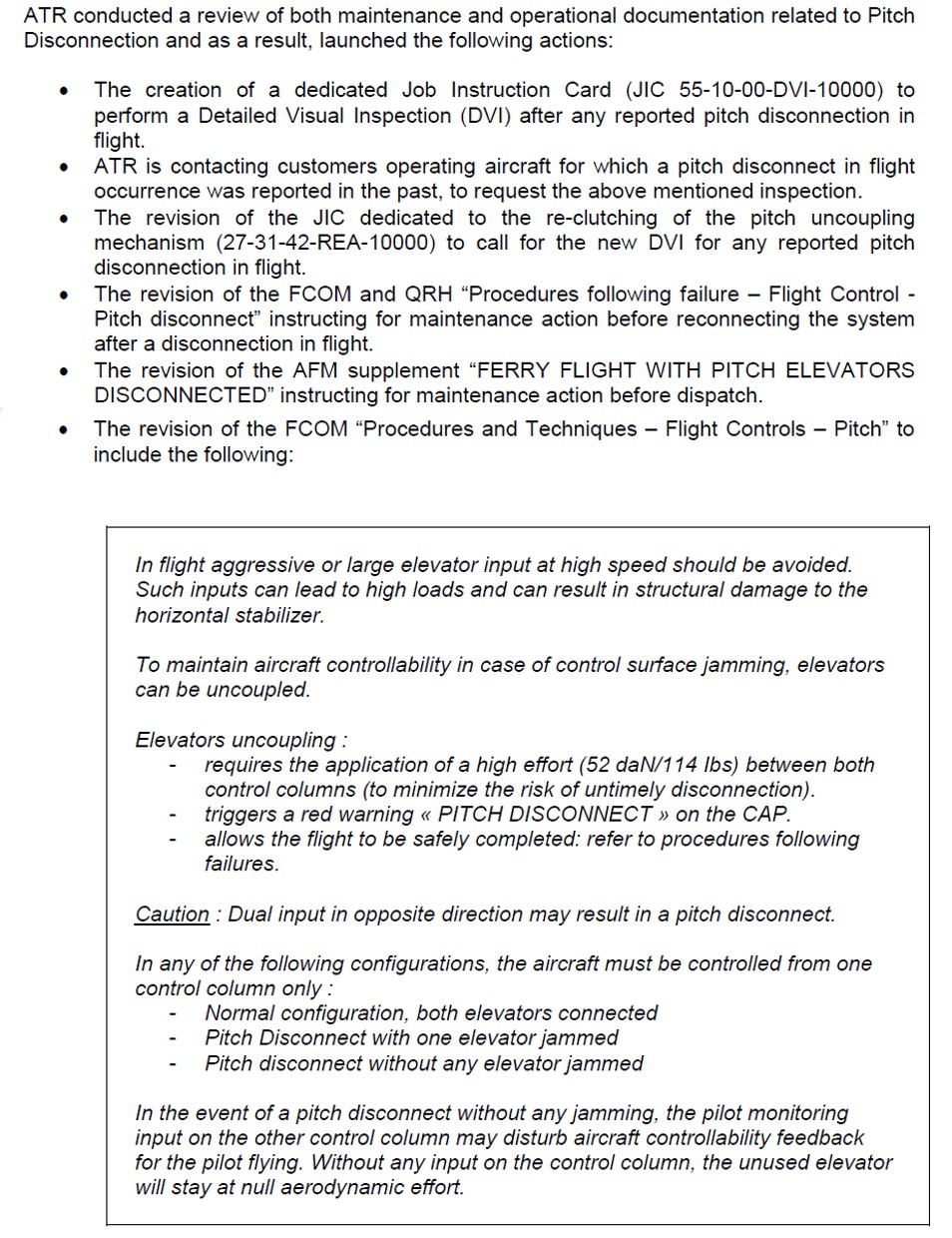Inadvertent application of opposing pitch control inputs by flight crew can activate the pitch uncoupling mechanism which, in certain high-energy situations, can result in catastrophic damage to the aircraft structure before crews are able to react.
When this safety issue was released, the reasons for the specified aircraft behaviour were not well understood so the issue was phrased in terms of an action with a problematic outcome. After further investigation by the ATSB and extensive analysis by ATR, the ATSB has identified a number of safety issues that address this scenario in more depth and therefore replace this safety issue.
Background to the safety issue
Initially, the ATSB was unaware of any other in-flight pitch disconnect occurrences on the ATR 42/72 series aircraft. As a result, the existing procedural risk controls were considered effective at maintaining a sufficiently low probability of a recurrence of the occurrence involving VH-FVR on 20 February 2014. As such, the ATSB did not initially consider that immediate safety action was necessary. However, once aware of other in-flight pitch disconnect occurrences, none of which were because of a jammed system, it became apparent that the related procedural risk controls were not sufficiently effective. The likelihood of an inadvertent in-flight pitch disconnect has been demonstrated to be higher than the initial assessment suggested. On 15 June 2016, the ATSB published an interim report that provided details about the occurrence, aircraft systems, stabiliser damage, and preliminary analysis of the event. In that report, the ATSB issued this safety issue to alert the aircraft manufacturer, regulatory authorities and aviation industry to the potential for damage from an in-flight pitch disconnect.
As a result of this occurrence and a briefing from the ATSB on 5 February 2016 on the safety issue, ATR released an All Operators Message (AOM). The message informed operators of ATR 42/72 aircraft of revised maintenance and operational documentation relating to the pitch control system and pitch disconnect occurrences as follows:

In relation to the continuing airworthiness of aircraft reported to have previously sustained an in‑flight pitch disconnect, ATR reported that they had contacted the relevant operators to ensure that all of the affected aircraft were subject to the new detailed visual inspections.
Toll Aviation and Toll Aviation Engineering advised that, as a result of this occurrence, they issued a safety alert to their flight crew and aviation maintenance engineers. This alert advised that, in the event of a pitch disconnect, the aircraft was to be grounded until the appropriate checks had been carried out.
The ATSB acknowledges the proactive safety action taken by the involved parties before and after this safety issue was released in the interim report of June 2016.
When this safety issue was released, the reasons for the specified aircraft behaviour were not well understood so the issue was phrased in terms of an action with a problematic outcome. After further investigation by the ATSB and extensive analysis by ATR, the ATSB has identified a number of safety issues that address this scenario in more depth.
Proactive safety action by Virgin Australia Regional Airlines and Virgin Australia Airlines[116:]
Virgin Australia Airlines advised that, in response to this occurrence, they had taken action to reduce the potential for pitch disconnects and to manage the risk of adverse outcomes from such occurrences. These included:
- reviewing and revising (where necessary) policy and procedures associated with descent speeds, handover and takeover procedures, overspeed recovery and on ground pitch disconnects
- incorporation of a number of factors surrounding the event into training material and simulator checks
- improved pilot awareness through Flight Crew Operations Notices, manufacturer’s communications (All Operators Messages) and on-going training and checking
- full induction for ex-VARA crew into the VAA safety management system
- updated maintenance requirements following a pitch disconnect
- compliance with all relevant points in the ATR All Operators Messages with respect to this event.
__________


